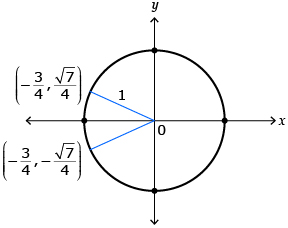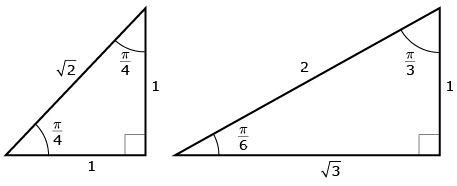In Try This 3 you looked at how the equation of the unit circle, x2 + y2 = 1, could be used to determine if points were on the unit circle. You may have substituted both the x- and y-coordinates into the equation for the unit circle and determined if the two sides of the equation were equal.
In Try This 3 question 2 you were asked to determine the y-coordinate when given the x-coordinate. Your answer should have looked something like the solution shown here. There are two solutions because the x-coordinate can be negative in both quadrants 2 and 3.

Read “Example 2” on page 183 of the textbook. Note the following as you read:
- The equation of the unit circle is used to determine the other coordinate.
- Remember that when you take the square root of a number, the answer could be positive or negative.
- Unless the quadrant is given in the question, it is important to determine the quadrants the coordinate could be in.
-
 becomes
becomes  at the end of the example. This is sometimes done so there are no radicals in the denominator. See the information on rationalizing denominators in Refresher if you need to review how this change is completed.
at the end of the example. This is sometimes done so there are no radicals in the denominator. See the information on rationalizing denominators in Refresher if you need to review how this change is completed.
Self-Check 2
Complete questions 2.a., 2.f., 3.b., and 3.f. on pages 186 to 187 in the textbook. Answer
In Try This 1 you created two number lines that formed two circles. One circle divided into 8 equal parts, and one circle divided into 12 equal parts. In Share 1 you were asked to determine the coordinates for  . You will use your answer to Try This 1 in Try This 4.
. You will use your answer to Try This 1 in Try This 4.
Try This 4
You will use Unit Circle Template to help organize the intersection points of terminal arms of angles and the unit circle. Print Unit Circle Template now.
- Fill in the central angle measurements for each terminal arm in the template using the circles you created in Try This 1. Remember that these circles were created by using a number line from 0 to 2π and then dividing the number line into 8 or 12 equal parts. Place each angle in the terminal-arm spaces on the template. The first quadrant has been completed for you.
- Fill in the x- and y-coordinates of the point of intersection of the terminal arm for the central angle
 and the unit circle. Watch Finding Coordinates Example for help in determining the coordinate ( ___, ___ ) on your template.
and the unit circle. Watch Finding Coordinates Example for help in determining the coordinate ( ___, ___ ) on your template.

- Use your knowledge of angles in all four quadrants to fill in all of the spaces in Unit Circle Template. Think about when x- and y-coordinates should be positive or negative.

While answering question 3, read “Example 3” on pages 184 and 185 in the textbook. Notice that the angle  can be placed in all four quadrants and then the coordinates determined.
can be placed in all four quadrants and then the coordinates determined.
 Save your responses in your course folder.
Save your responses in your course folder.
You will use your unit circle in future lessons of this module.
Share 3
With a partner or in a group, discuss the following questions.
- Examine the angles on your unit circle. Describe any patterns you see.
- Examine the coordinates on your unit circle. Complete question 11 on page 188 in your textbook.
 If required, save a record of your discussion in your course folder.
If required, save a record of your discussion in your course folder.


